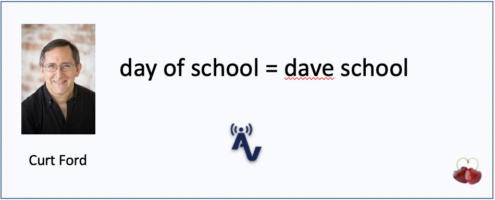50 – day of school = dave school
I have long contended that ELT’s ‘rules of connected speech’ are inadequate to describe what happens in the stream of normal spontaneous speech (see here). They are inadequate, in other words, to help with the listening challenges that many if not most learners face when listening to ‘real stuff’.
My colleague Curt Ford who has a lovely listening website here which features a blog post which came about as a result of a discussion we had about one of his examples.
One of the rules of connected speech predicts that given the words ‘day of school’ the Greenhouse pronunciations of the two words |deɪ.ɒv| will become – in the Garden pronunciation – linked by a glide giving |deɪ.ʲɒv|. Have a listen and see what you think.
After we discussed this example, Curt and I agreed that the two words ‘day of’ become a single syllable sounding very close to ‘Dave’ so we don’t get |deɪ.ʲɒv| we get something close to |deɪv|. The two syllables have become one – in my terms a ‘syllablend’ has occurred, resulting in a ‘sylldrop’ (cf. Cauldwell, 2018: 111-113).
Listen to ‘day of’ as ‘dave’ in this extract (it occurs three times).
Curt has now put together a collection of similar examples here, with nice dictation exercises.
I believe it is important for teachers and materials writers to spend some time with their capacity to make meaning turned off, and use this time to attend to the nature of the sound substance. We should realise that soundshapes may occur which are in defiance of meaning and context. Thus we get ‘Dave school’ for ‘day of school’ in the sound substance, even though in context/meaning terms this results in nonsense.
Also – and this is very important – you may disagree that ‘day of’ has become ‘dave’ – and that’s fine. But I would implore you to allow the validity of alternative hearings of the sound substance. By this I mean that it is perfectly reasonable and acceptable for people to have different perceptions of what the sound substance sounds like to them. Particularly when ‘different people’ include your students: they may be far better than you at dissociating meaning from substance, and their perceptions may be closer to the realities of the sound substance than your own.
Back to Curt’s website – here’s another of his examples – have a listen. What sound shape do you hear? What do you think the words are that the speaker intended to say?
Now go to Curt’s website here and see if you are right.
Cauldwell, R.T. (2018). A Syllabus for Listening – Decoding. Birmingham: Speech in Action. Available here.


